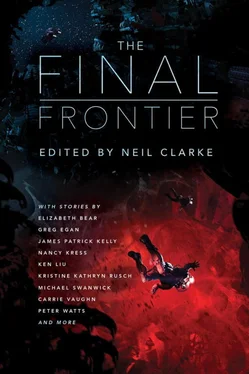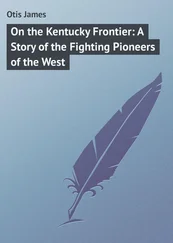2.
The world the Noudah called home was the closest of the system’s five planets to their sun. The average temperature was one hundred and twenty degrees Celsius, but the high atmospheric pressure allowed liquid water to exist across the entire surface. The chemistry and dynamics of the planet’s crust had led to a relatively flat terrain, with a patchwork of dozens of disconnected seas but no globe-spanning ocean. From space, these seas appeared as silvery mirrors, bordered by a violet and brown tarnish of vegetation.
The Noudah were already leaving their most electromagnetically promiscuous phase of communications behind, but the short-lived oasis of Amalgam-level technology on Baneth, the gas giant’s moon, had had no trouble eavesdropping on their chatter and preparing an updated cultural briefing which had been spliced into Joan’s brain.
The planet was still divided into the same eleven political units as it had been fourteen years before, the time of the last broadcasts that had reached the node before Joan’s departure. Tira and Ghahar, the two dominant nations in terms of territory, economic activity, and military power, also occupied the vast majority of significant Niah archaeological sites.
Joan had expected that they’d be noticed as soon as they left Baneth—the exhaust from their fusion engines glowed like the sun—but their departure had triggered no obvious response, and now that they were coasting they’d be far harder to spot. As Anne drew closer to the homeworld, she sent a message to Tira’s traffic control center. Joan tuned in to the exchange.
“I come in peace from another star,” Anne said. “I seek permission to land.”
There was a delay of several seconds more than the light-speed lag, then a terse response. “Please identify yourself and state your location.”
Anne transmitted her coordinates and flight plan.
“We confirm your location, please identify yourself.”
“My name is Anne. I come from another star.”
There was a long pause, then a different voice answered. “If you are from Ghahar, please explain your intentions.”
“I am not from Ghahar.”
“Why should I believe that? Show yourself.”
“I’ve taken the same shape as your people, in the hope of living among you for a while.” Anne opened a video channel and showed them her unremarkable Noudah face. “But there’s a signal being transmitted from these coordinates that might persuade you that I’m telling the truth.” She gave the location of the decoy node, twenty light-years away, and specified a frequency. The signal coming from the node contained an image of the very same face.
This time, the silence stretched out for several minutes. It would take a while for the Tirans to confirm the true distance of the radio source.
“You do not have permission to land. Please enter this orbit, and we will rendezvous and board your ship.”
Parameters for the orbit came through on the data channel. Anne said, “As you wish.”
Minutes later, Joan’s instruments picked up three fusion ships being launched from Tiran bases. When Anne reached the prescribed orbit, Joan listened anxiously to the instructions the Tirans issued. Their tone sounded wary, but they were entitled to treat this stranger with caution, all the more so if they believed Anne’s claim.
Joan was accustomed to a very different kind of reception, but then the members of the Amalgam had spent hundreds of millennia establishing a framework of trust. They also benefited from a milieu in which most kinds of force had been rendered ineffectual; when everyone had backups of themselves scattered around the galaxy, it required a vastly disproportionate effort to inconvenience someone, let alone kill them. By any reasonable measure, honesty and cooperation yielded far richer rewards than subterfuge and slaughter.
Nonetheless, each individual culture had its roots in a biological heritage that gave rise to behavior governed more by ancient urges than contemporary realities, and even when they mastered the technology to choose their own nature, the precise set of traits they preserved was up to them. In the worst case, a species still saddled with inappropriate drives but empowered by advanced technology could wreak havoc. The Noudah deserved to be treated with courtesy and respect, but they did not yet belong in the Amalgam.
The Tirans’ own exchanges were not on open channels, so once they had entered Anne’s ship Joan could only guess at what was happening. She waited until two of the ships had returned to the surface, then sent her own message to Ghahar’s traffic control.
“I come in peace from another star. I seek permission to land.”
3.
The Ghahari allowed Joan to fly her ship straight down to the surface. She wasn’t sure if this was because they were more trusting, or if they were afraid that the Tirans might try to interfere if she lingered in orbit.
The landing site was a bare plain of chocolate-colored sand. The air shimmered in the heat, the distortions intensified by the thickness of the atmosphere, making the horizon waver as if seen through molten glass. Joan waited in the cockpit as three trucks approached; they all came to a halt some twenty meters away. A voice over the radio instructed her to leave the ship; she complied, and after she’d stood in the open for a minute, a lone Noudah left one of the trucks and walked toward her.
“I’m Pirit,” she said. “Welcome to Ghahar.” Her gestures were courteous but restrained.
“I’m Joan. Thank you for your hospitality.”
“Your impersonation of our biology is impeccable.” There was a trace of skepticism in Pirit’s tone; Joan had pointed the Ghahari to her own portrait being broadcast from the decoy node, but she had to admit that in the context her lack of exotic technology and traits would make it harder to accept the implications of that transmission.
“In my culture, it’s a matter of courtesy to imitate one’s hosts as closely as possible.”
Pirit hesitated, as if pondering whether to debate the merits of such a custom, but then rather than quibbling over the niceties of interspecies etiquette she chose to confront the real issue head-on. “If you’re a Tiran spy, or a defector, the sooner you admit that the better.”
“That’s very sensible advice, but I’m neither.”
The Noudah wore no clothing as such, but Pirit had a belt with a number of pouches. She took a handheld scanner from one and ran it over Joan’s body. Joan’s briefing suggested that it was probably only checking for metal, volatile explosives, and radiation; the technology to image her body or search for pathogens would not be so portable. In any case, she was a healthy, unarmed Noudah down to the molecular level.
Pirit escorted her to one of the trucks, and invited her to recline in a section at the back. Another Noudah drove while Pirit watched over Joan. They soon arrived at a small complex of buildings a couple of kilometers from where the ship had touched down. The walls, roofs, and floors of the buildings were all made from the local sand, cemented with an adhesive that the Noudah secreted from their own bodies.
Inside, Joan was given a thorough medical examination, including three kinds of full-body scan. The Noudah who examined her treated her with a kind of detached efficiency devoid of any pleasantries; she wasn’t sure if that was their standard bedside manner, or a kind of glazed shock at having been told of her claimed origins.
Pirit took her to an adjoining room and offered her a couch. The Noudah anatomy did not allow for sitting, but they liked to recline.
Pirit remained standing. “How did you come here?” she asked.
Читать дальше












